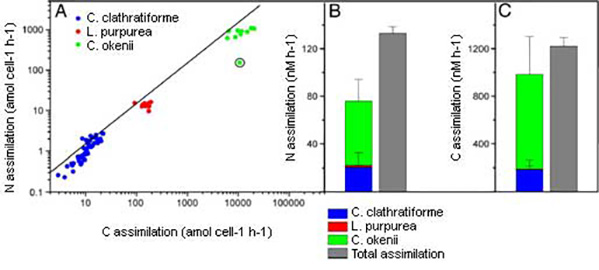Ecophysiology of anaerobic phototrophic bacteria: 15N and 13C uptake
This publication demonstrates the ability of the
NanoSIMS to analyze the ecophysiological role of individual cells, including less abundant and less active microbes, without culture
Individual cells of the anaerobic phototropic bacteria Chromatium okenii, Lamprocystis purpurea and Chlorobium clathratiforme inhabiting the oligotrophic meromictic Lake Cadagno, stratified alpine lake in Switzerland, have been analyzed with respect to H
13CO
3- and
15NH
4+ assimilation. Water samples from 11.5 m depth were incubated after the addition of
15N-labeled ammonium and
13C-labeled bicarbonate at in situ light and temperature conditions. After incubation the samples were hybridized with HRP-labeled oligonucleotide probes targeting specific regions of the 16S rRNA of the three species. After the deposition of fluorine-containing tyramides, filters were immediately analyzed with the NanoSIMS.
For each acquisition,
12C,
13C,
19F,
12C
14N,
12C
15N images are recorded in parallel. Regions of interest (ROI) are drawn around individual cells from which pixel intensities are summed then ratioed.
19F images are elemental-FISH images signing the phylogenetic identity,
13C/
12C and
15N/
14N ratio images measure the metabolic activity.

A: the line represents the theoretical "Redfield" C:N ratio of 6.6
B: Contribution to the total ammonium
C: Contribution to total dissolved inorganic carbon and assimilation in the system by each population
For the calculation of total nitrogen and carbon uptake, the absolute abundance of each species as determined by CARD-FISH was taken into account
A large variability in metabolic rates between individual cells of the same species is observed. The microbial populations in the environment are heterogeneous, comprising physiologically distinct individuals.
C. okenii, the least abundant species representing about 0.3% of the total cell number contributes more than 50% of the total ammonium and carbon uptake in the system. This reveals the significance of inconspicuous microbes to the nitrogen and carbon cycles in the environment.
Combining an isotopic incubation experiment with phylogenetic labeling (in situ, elemental, or fluorescent in an optical microscope), the
NanoSIMS allows microbiologists to
quantify the metabolic activity and interactions of individual microbes in their environment, without culture.
From: A single cell view on the ecophysiology of anaerobic phototrophic bacteria. N. Musat et al., PNAS, Nov. 18, 2008, vol. 105, no. 46.